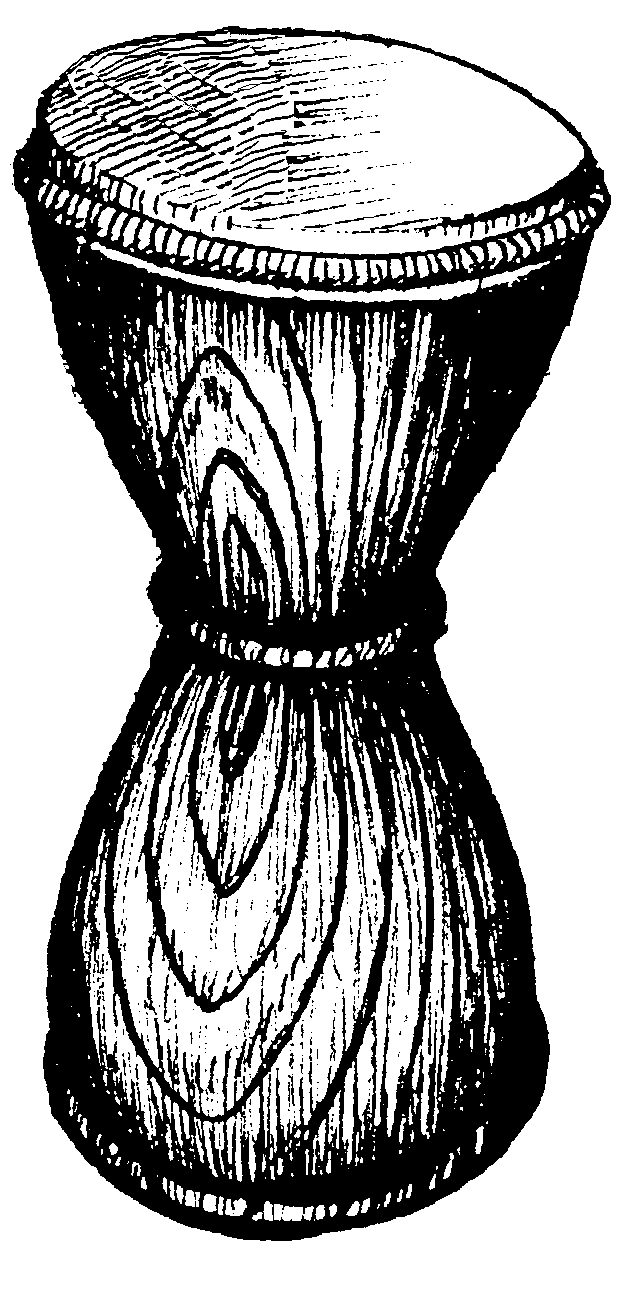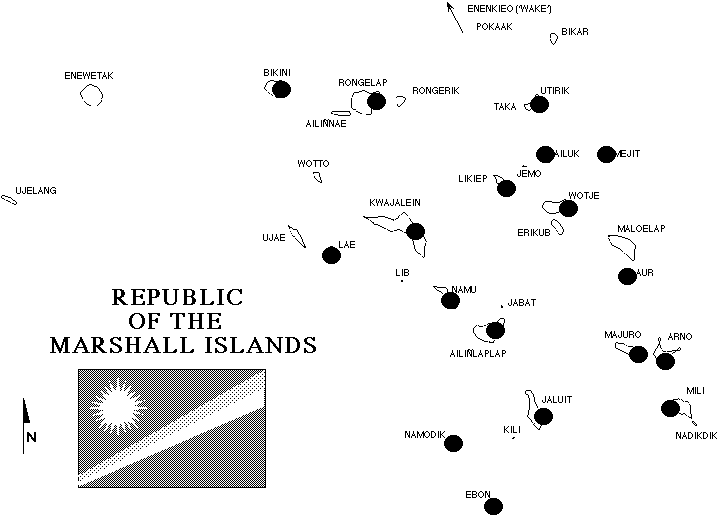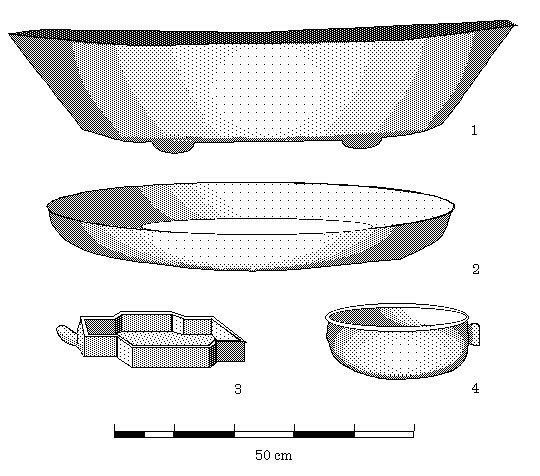

|

|
WWW Resources on the Marshall Islands
Traditional utilization of Mangroves in the Marshall Islands |
Mangroves are coastal plants growing in well defined ecological contexts within a transsect perpendicular to the shoreline ("mangrove zonation"). Commonly, the intertidal water's edge is occupied by Rhizophora spp. or Sonneratiaalba, while the permanently dry land (save for spring tides and storms waves), is often occupied by Pemphis acidula. Although Bruguieracan withstand a wide salinity range, it prefers stands which have a substantially lower salinity than sea water, preferably on dry land or only tidally covered land. In the Marshall Islands, mangroves, especiallyBruguiera, are commonly found in inland low wet spots, termed "mangrove depressions" (pat).
Distribution of Bruguiera gymnorrhiza in the Marshall Islands
Bruguiera gymnorhiza is a common mangrove plant which has a global distribution from tropical Africa, Australia and South and Southeast Asia to the tropical Pacific. Bruguiera gymnorhiza stands have been reported from a number of atolls of the Marshall Islands, namely Bikini, Rongelap, Utirik, Lae, Ailuk, Likiep, Aur, Ailinglaplap, Majuro, Arno, Ebon, Jaluit, Namu, Wotje, Mile, Mejit and Kwajalein. Its absence from the northern atolls of Taongi and Bikar as well as from Wake Island, seems to be closely related to the level of annual precipitation on the atolls, which decreases the further north the atoll is located. The absence of Bruguiera from Taka, Jemo Island, Wotho, Rongerik and Erikup as well as Kili and Enewetak, however, cannot be explained in terms of lack of precipitation. Other factors, such as cultural propagation, must be involved.
Mangrove utiliation in the Marshallese cultural
Horticulture and arboriculture is not limited to edible plants but extends to those plants which are useful to people one way or another, be it for medicine, construction, manufacture or even fragrance. In the Marshall Islands, four levels of human interaction with useful plants can be distinguished:
Artificial propagation of Bruguiera gymnorhiza was noted by Hathaway on Arno Atoll, where on Tutu Island a freshwater swamp was encountered with only very young Bruguiera trees. Upon enquiry it transpired that the trees had been planted sometime between 1933 and 1942. The artificial propagation and `cultivation' of Bruguiera gymnorhiza is also reported by ethnographic evidence of the 19th and 20th century. Some experts even speculates that Bruguiera may have been a non-indigenous cultivar introduced to the Marshall Islands in pre-European times.
This artificial propagation seems to coincide with actions by the Marshallese to retain land gained during typhoon events, as is evidenced by the planting of scrubs and coconuts on newly created strand walls.
Another important aspect to be considered is the reported presence of theton (Anguilla celebensis) in the pat. The ton, as a freshwater fish (eel) not native to coral reefs, seems incapable of migration to the Marshall Islands on its own and seems to have been intentionally imported to the atolls of the Marshall Islands. Apart from the pat on Delap, the presence of ton is also reported for the interior of Namorikand for Jaluit. The distribution of the eel is confined to the southern atollsof the Marshall Islands, those atolls which were in contact with the islands to the west. It appears, that the ton is an animal introduced by deliberate human actions from a source in the west, possibly Kosrae or Pohnpei.

A wooden Aje Drum (Waist drum), commonly made from kone wood (Pisoniagrandis), occasionally made from joñ wood with a drum surface made from the inner lining of a shark's stomach.
Such a connection is the more interesting as mangroves are very commonon those islands. Following from this, it can be speculated that theBruguiera and the eel Anguilla celebensis may have been imported--among other cultivars and animals(?)--as part and parcel of the same "swamp improvement package" from these islands. Apart from some equivocal linguistic data, however, there is at present little tangible evidence for this assumption, as archaeological data do not allow for any such analyses.
Distribution patterns
The distribution of the Bruguiera in the Marshall Islands has been plotted and the distribution of the Anguilla eels does not match the distribution of the Bruguiera trees, although mangroves are present on all those islands and atolls from which the eel is reported. Other data to be drawn are based on the distribution of place names, namely the distributions ofwato names of atolls of the Marshall Islands, which contain as a formant the words for mangrove (jon) or inland wetland depression(pat).
Although the name of a wato may have changed over time, it can be assumed to be older than the past 200 years. The pat-watos are common throughout the Marshall Islands and are only absent on the uninhabited or only infrequently inhabited islands. The distribution of the Bruguiera trees matches that of the pat-watos reasonably well with some exceptions on both sides. However, the use of the term pat can also refer to a swamp or depression in general and need not specify a mangrove swamp. The distribution of the wato names with the formant jon, however,indicates those watos on islands/atolls, where the occurrence ofBruguiera gymnorrhiza was considered to be important. These atolls are concentrated in the southern Marshalls. The distribution of the eel is concentrated even more on the southern atolls, with the exception of Mile and Ebon.

Distribution of Bruguiera spp./Jon mangroves on the Marshall Islands.
In summing up, the southern atolls of the Marshall Islands show a greater concentration of variables than the northern ones. To some extent this may be due to rainfall characteristics, although, as has been mentioned above, human dispersal is a key factor. The traditional communication links in the Marshall Islands, modified by sailing conditions and political configurations, seem to have been restricted to the individual chains: that is, the northern atolls of the Ralik Chain had contact with the atolls of the southern Ralik Chain, but only rarely contact with northern atolls of the Ratak Chain. In the time just prior to and during the period of the initial contact with Europeans, the southern Marshalls, namely Ebon, Jaluit, Mile, Arno and Majuro maintained afrequent, though irregular contact between the chains. Thus it is feasible that the mangroves and eels, if imported from the west, entered the Marshall Islands by way of Namorik and Jaluit, from where they were traded/ exchanged eastward to Majuro/Arno and northward in both chains.
Use of mangroves in Marshallese culture
The joñ tree (Bruguiera conjugata; B. gymnorhiza) had a variety of uses in traditional material culture of the Marshall Islands. Utilised were the wood, the bark, the flowers and the propagules (kabbok in leen). Modern informants on traditional Marshallese culture claim that the wood, which is widely reported to be very tough, was used for structural components of traditional Marshallese houses, such as beams, posts and rafters. It was used also for canoe parts, such as the keel-piece (maal), the outrigger boom (kie) and outrigger struts (kein-eon erre).
In addition, small items, such as fishing spears (made), copra-huskers (doon) and small basket-type fishtraps (u) were made from the branches. The bark of the tree was utilised to make rope(s) and string for fishing nets, as well as for traditional medicine, especially to cure fish poisoning. The red flowers were, and still are, sometimes used as flower garlands (leis and wuts).
The propagules were the main part of the tree used as a dye in traditional culture: stripped of their outer rind, the propagules were cut up and boiled in helmet shells (Cassis cornuta) or coconut shells. The fibres to be dyed were then soaked in the resulting broth and dried in the shade. The broth was used for colouring and strengthening fibres, such as those of fishing nets made of coconut fibres or grass skirts and other items made of loo (Hibiscus tiliaceus). The initial colouring seems to have been red-brownand repeated soaking resulted in a black colour. The dye made of the propagules had also a sealing effect, stopping the dye from running if the woven artifact became wet.

Wooden food preparation and serving vessels. 1-collected on Majuro; 2-4-collected onLae.(drawn after Krämer)
| select from the following... | ||||||
| |
||||||
|
Digital Micronesia-An
Electronic
Library & Archive
is provided free of charge
as an advertising-free
information service
for the world community. It is being maintained by Dirk
HR Spennemann, Associate
Professor in Cultural
Heritage Management, Institute of Land, Water and Society and School
of Environmental & Information Sciences, Charles
Sturt University,
Albury, Australia. The server
space and technical support are provided by Charles
Sturt University as part of its commitment
to regional engagement. Environmental
SciencesInformation
Sciences
|
||||||